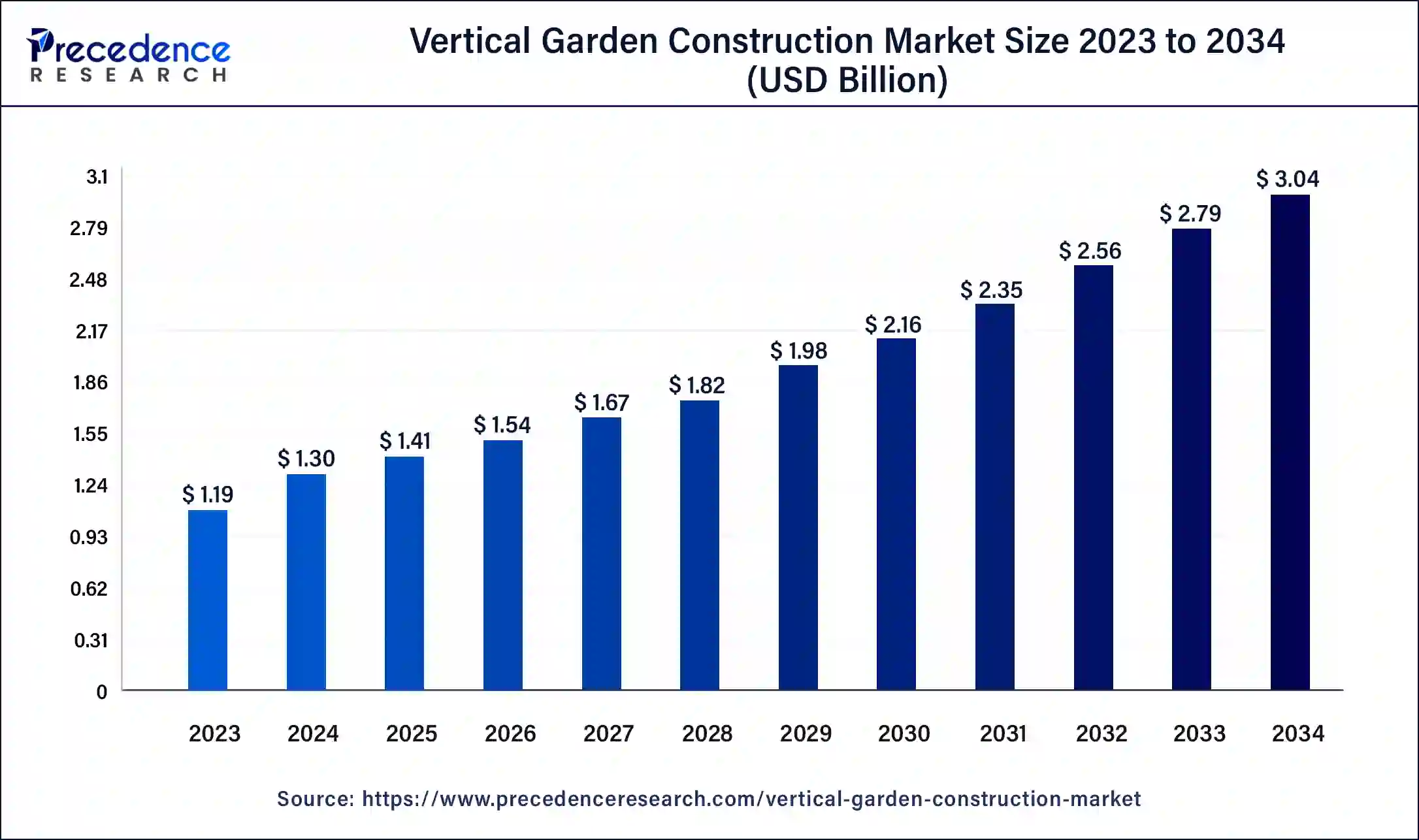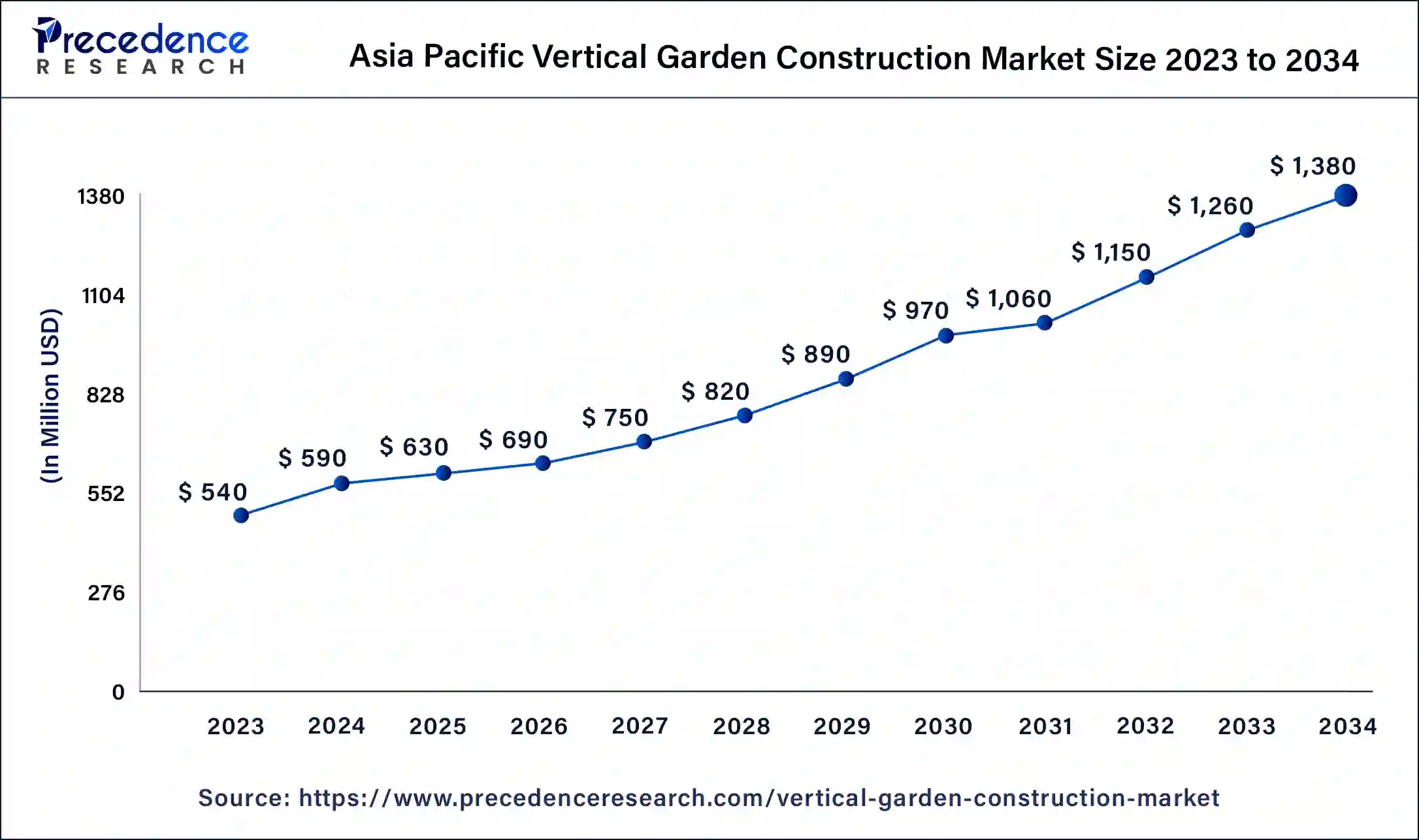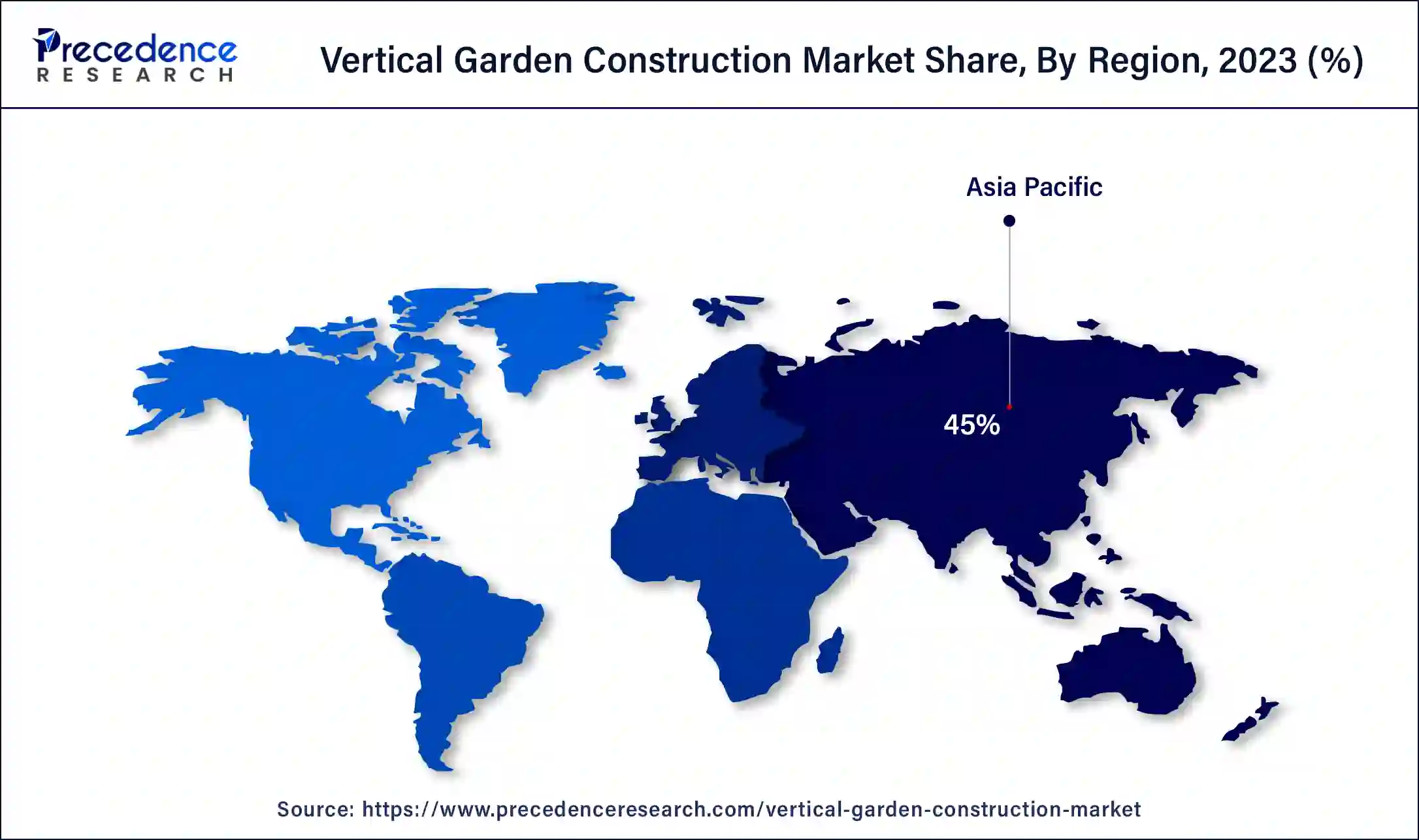May 2025
The global vertical garden construction market size was calculated at USD 1.30 billion in 2024 and is anticipated to reach around USD 3.04 billion by 2034, growing at a CAGR of 8.87% over the forecast period 2025 to 2034. The vertical garden construction market growth is attributed to the growing demand for advanced garden solutions in urban areas.

Artificial intelligence (AI) is utilized in the construction of vertical gardens as it improves the design process and helps to manage the plants. Artificial intelligence is employed in the vertical garden construction market to determine particular plant species that grow optimally in different microclimatic conditions of the environment. This systematic way is beneficial in terms of the prevention of plant failure and also a big advantage for designers, as they match plants according to their growth patterns and colors. Furthermore, the use of AI in monitoring enables the management of crops to be conducted on a real-time basis regarding humidity, light, and nutrients to ensure proper timing of irrigation and application of fertilizers.
The Asia Pacific vertical garden construction market size was exhibited at USD 590 million in 2024 and is projected to be worth around USD 1,380 million by 2034, poised to grow at a CAGR of 8.90%.

Asia Pacific led the vertical garden construction market in 2024, owing to the growing concerns of urbanization, where increased population density affects conventional landscape design, notably in countries including China and India. They are also initiating environmentally friendly programs to tackle the effects of heat islands and smog in this area. Moreover, there is a rising demand for residential gardening services since people want green vegetation in their homes.

North America is observed to witness the fastest rate of growth in the vertical garden construction market during the forecast period due to the rising trend in sustainable building practices or green building practices in residential and commercial buildings. Vertical gardens are becoming in demand due to New York and San Francisco’s policy of installing green areas. Furthermore, there is increasing urbanization and an increasing propensity for people to indulge in biophilic designs.
Growing consciousness of the environment, as the city's residents focus on infrastructural development for better control of global warming and shortage of green areas. This market incorporates sophisticated systems such as hydroponic systems and smart irrigation systems that enable the efficient use of water to improve the health of plants. The programs from the World Green Building Council stressed green technologies in terms of aesthetic value, together with the prospect of positively impacting the environment.
| Report Coverage | Details |
| Market Size by 2034 | USD 3.04 Billion |
| Market Size in 2025 | USD 1.41 Billion |
| Market Size in 2024 | USD 1.30 Billion |
| Market Growth Rate from 2025 to 2034 | CAGR of 8.87% |
| Largest Market | Asia Pacific |
| Base Year | 2024 |
| Forecast Period | 2025 to 2034 |
| Segments Covered | Application, Type, Garden Type, and Regions |
| Regions Covered | North America, Europe, Asia-Pacific, Latin America and Middle East & Africa |
Rising interest in indoor gardening
Rising interest in indoor gardening contributes to the growth of the vertical garden construction market as a practical solution for urban dwellers, thus driving the market. Consumers tend to design their homes with some form of green encompasses in their interior living spaces, hence prompting the need to install vertical gardens on walls with limited floor space. These installations used to grow plants all year round, and the indoor air quality would be improved, and overall productivity would be enhanced.
The increased trend of living in apartments in urban areas with every indication of living in even tinier units helps cement vertical gardens as a suitable fit for interiors. This growing trend goes hand in hand with the versatility of the concept of vertical gardening, which offers its services to a wide range of consumers willing to bring nature indoors.
| Year | Percentage of Households Engaging in Indoor Gardening (U.S.) | Projected Urban Population (% of Total Population) | Indoor Air Quality Improvement (% Reduction in Pollutants) |
| 2019 | 23% | 55% (2019) | 80% |
| 2020 | 25% | 56% (2020) | 85% |
| 2021 | 29% | 57% (2021) | 87% |
| 2022 | 32% | 60% (2022) | 87% |
| 2023 | 35% | 62% (2023) | 87% |
| 2024 | 40% (Projected) | 65% (Projected) | 90% (Projected) |
Hamper high initial costs
High initial costs hamper the adoption of vertical gardens, deterring potential customers from investing in these installations and further hampering the vertical garden construction market. These costs include the cost of the material used to make the structure and installation costs, which are more expensive than general gardening. Furthermore, as consumers focus on isles and adopt a more price-conscious approach, the growth of the segment may offer a significantly lower vertical gardening product.
Rising technological advancements
Rising technological advancements in vertical gardens are expected to create immense opportunities for the players competing in the vertical garden construction market. Modern advances in the field of irrigation practices and controls, smart applications to manage gardens, and innovative architectural designs make it easier and more convenient to maintain and make gardens available widely. Manufacturers are focusing on developing smart technologies that make it easy to monitor the health of the plants in the vertical gardens in real time, hence enabling users to manage the gardens well.
A study that ASLA conducted shows that 57% of the current landscape architecture firms integrate technology in their design, thus enhancing the innovativeness factor.
The outdoor vertical garden wall segment accounted for a considerable share of the vertical garden construction market in 2024 due to the growing need for additional green areas. A high number of the world’s population lives in urban areas where land is scarce, creating demand for vertical garden solutions. This method is effective in improving the quality of the block facade, public areas, and squares, providing for the biotic diversity of plantings. Moreover, the higher than traditional business growth of environmentally friendly architecture and the urban greening projects further boosts the utilization of outdoor vertical garden walls.
The indoor vertical garden wall segment is anticipated to grow with the highest CAGR in the vertical garden construction market during the studied years, owing to the increasing customer demand for indoor plants and general uptake in the use of plants within households and workplaces. Bringing the gym to an indoor vertical garden creates beauty and quality air, and studies show that quality air conditions lead to an increase in productivity and reduced stress levels. Furthermore, new technological trends in smart irrigation and plant care systems reduce the complexity of maintenance, further creating demand for indoor vertical garden wall solutions among property owners and companies.
The green wall vertical garden segment led the global vertical garden construction market due to the rising levels of urbanization and the emerging biophilic design that incorporates natural aspects into manmade buildings. Green walls give considerable aesthetic value since they change dull walls to eye-catching green walls with vegetation on them. Megastores hotels join other businesses that incorporate the green walls in the supply chain as a way of enhancing the customer's experience.
The green facades vertical garden segment is projected to expand rapidly in the vertical garden construction market in the coming years. Climbing Plants grown on trellises or frameworks that are categorized as green facades have the big advantage of lowering heat absorption insulation. They assist in fostering the conservation of biodiversity since they afford the wildlife in urban areas a space to live, making them desirable to environmentally friendly stakeholders, additionally, with the rising popularity of green solutions and demand for eye-catching urban looks.
The commercial segment held a dominant presence in the vertical garden construction market in 2024 due to the growing trend for making green space within cities. Companies understand the value of integrating vertical gardens into their design since such features improve looks and provide a boost to ventilation. Public areas, including the hotel restaurant and office facilities, use vertical gardens to entice buyers, creating improved buyer environments and improving employee health. Furthermore, the expanding number of greening activities by municipalities and commercial installations further boosts the segment.
The residential segment is expected to grow at the fastest rate in the vertical garden construction market during the forecast period of 2024 to 2034, owing to the increase in small spaces, also known as indoor gardening, and homeowners' desire to make their homes aesthetically appealing. People are coming up with some techniques to incorporate features that have greenery in them within their homes, especially those living in towns. People have become aware of the health benefits associated with indoor plants, such as improving the quality of air and mental well-being. Furthermore, improvements in technology, including smart gardening systems, will make gardening easier.
By Application
By Type
By Garden Type
By Geography
For inquiries regarding discounts, bulk purchases, or customization requests, please contact us at sales@precedenceresearch.com
No cookie-cutter, only authentic analysis – take the 1st step to become a Precedence Research client
May 2025